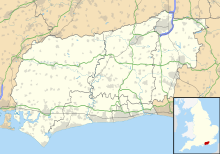RAF Bognor
This article needs additional citations for verification. (October 2020) |
RAF Bognor | |||||||||||||||
|---|---|---|---|---|---|---|---|---|---|---|---|---|---|---|---|
| Summary | |||||||||||||||
| Airport type | Military | ||||||||||||||
| Owner | Air Ministry | ||||||||||||||
| Operator | Royal Air Force | ||||||||||||||
| Location | Bognor, West Sussex | ||||||||||||||
| Opened | June 1, 1943 | ||||||||||||||
| Closed | November 6, 1944[1] | ||||||||||||||
| Built | 1943 | ||||||||||||||
| In use | 1943-44 | ||||||||||||||
| Coordinates | 50°47′15″N 000°42′30″W / 50.78750°N 0.70833°WCoordinates: 50°47′15″N 000°42′30″W / 50.78750°N 0.70833°W | ||||||||||||||
| Map | |||||||||||||||
 RAF Bognor Location in West Sussex | |||||||||||||||
| Runways | |||||||||||||||
| |||||||||||||||
RAF Bognor (also known as Bognor Advanced Landing Ground (A.L.G.)) is a former Royal Air Force Advanced Landing Ground 2 miles (3.2 km) north of Bognor, West Sussex, England.[2]
History[]
Survey work on the site was undertaken in "mid-1942", with construction beginning in early 1943, completed by the Royal Canadian Engineers.[3] Bognor was one of 82 planned sites planned with only 26 being built. The original budget for the site was £20,500.[4] The airfield became operational on the 1st of June 1943 with two intersecting Sommerfield track runways. The site was under the control of RAF Tangmere located four miles further north.
The site was originally a training site for aircrews to practise operating with few facilities, however, in Autumn 1943, extra over blister hangars were installed. These provided shelter for most aircraft that were stationed at Bognor, little accommodation was provided for the aircrews who lived in tented camps. The site was used as a forward staging base for a number of fighter and ground attack units for the D-Day assault, however, these soon moved to back to Tangmere and were replaced by 83 Group and 1310 Flight. 1310 flew Ansons from Bognor in an air ambulance and medical supply capacity to the advancing forces on the French coastline.[5][2]
83 Group left the site in late September 1944 and need for the airfield ceased to exist. Runway removal works were carried out during the Autumn of 1944 and by early 1945, the site had been returned to its original owners. Parts of the site have now been built over by the expanding Bognor Regis or returned to farmland with few noticeable remnants of the airfield remaining.
Units[]
| Squadron | Dates | Aircraft |
|---|---|---|
| No. 19 Squadron RAF | 6 Jun 1943-2 Jul 1943 | Supermarine Spitfire |
| No. 66 Squadron RAF | 31 Mar 1944-22 Jun 1944 | Supermarine Spitfire |
| No. 122 Squadron RAF | 1 Jun 1943-1 Jul 1943 | Supermarine Spitfire |
| No. 331 Squadron RAF | 31 Mar 1944-22 Jun 1944 | Supermarine Spitfire |
| No. 332 Squadron RAF | 31 Mar 1944-22 Jun 1944 | Supermarine Spitfire |
| No. 602 Squadron RAF | 1 Jun 1943-1 Jul 1943 | Supermarine Spitfire |
| No. 1310 Flight RAF | 25 Jun 1944-21 Jul 1944 | Avro Anson |
| No. 83 (Composite) Group | 25 Jun 1944-25 Sep 1944 | Supermarine Spitfire, Mustang IV, Typhoon |
Additional units:
- No. 2765 Squadron RAF Regiment[1]
- No. 2893 Squadron RAF Regiment[1]
- No. 2894 Squadron RAF Regiment[1]
- No. 3205 Servicing Commando[1]
- No. 3207 Servicing Commando[1]
References[]
- ^ a b c d e f "Bognor (Landplane)". Airfields of Britain Conservation Trust UK. Retrieved 2 October 2020.
- ^ a b Delve, Ken (7 August 2005). The Military Airfields of Britain: Southern England - Kent, Hampshire, Surrey, Sussex (in English and English). pp. 44–45. ISBN 1-86126-729-0. OL 8629602M. Wikidata Q105271144.
- ^ chichesterpost.co.uk (31 May 2019). "Changing Times - Farmland became bustling wartime airfield". Bognor Regis Post. Retrieved 3 October 2020.
- ^ "Advanced Landing Ground, Chalcraft Lane - Sylvia Endacott". Sussex Views Magazine. 12 April 2020. Retrieved 3 October 2020.
- ^ Cipirska, Isabella (20 May 2019). "Watch a Chinook helicopter land in Bognor for 75th anniversary event". Bognor Regis Observer. Retrieved 3 October 2020.
- Royal Air Force stations in West Sussex
- Royal Air Force stations of World War II in the United Kingdom

